The Role of Graphic Hoodies and Sweatshirts in Skate Culture
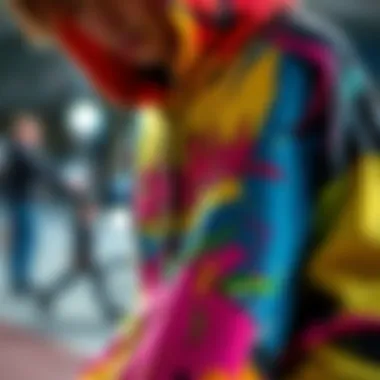
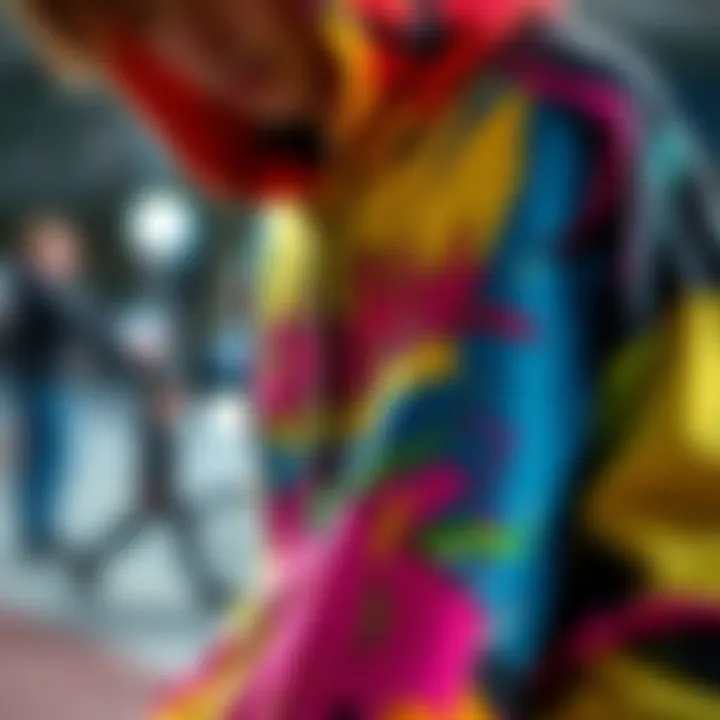
Intro
The blend of aesthetics and functionality is a cornerstone of skate culture, particularly when it comes to graphic hoodies and sweatshirts. These garments are not just clothing; they serve as statements of identity, self-expression, and community belonging. Each graphic tells a story, whether it’s a homage to skate legends or a nod to the artist's unique vision.
Diving into this topic sheds light on how skateboarding transcends mere sport, morphing into a lifestyle. The hoodie or sweatshirt can be as crucial as a skateboard itself for many skaters. Beyond their practical use during chilly sessions or as comfortable lounge wear, these pieces encapsulate the essence of skate culture. From the streets of Los Angeles to the parks in New York City, the visuals on these garments often reflect both the local and global skate scenes, revealing the intricacies of a vast subculture that thrives on individuality and creativity.
As we journey through the realms of graphic designs, production techniques, and cultural significance, we aim to reveal how essential these articles of clothing are for skateboarders and the community at large. Their roots run deep, intermingling personal history with collective experience, shaping not only how skateboarders outfit themselves but also how they connect with their peers.
Prologue to Graphic Hoodies and Sweatshirts
The realm of skate culture is not just about tricks and flips; it's an amalgamation of art, identity, and community. Among the most prominent artifacts of this culture are graphic hoodies and sweatshirts. These garments have evolved far beyond their simple fabric origins, serving as canvases for expression, history, and lifestyle.
Graphic hoodies and sweatshirts play a significant role in shaping how skateboarders present themselves. They're not merely items of clothing; they are a badge of belonging, telling stories of the wearers and their connections to skating communities. When someone throws on a hoodie adorned with the emblem of their favorite skate brand, they signal allegiance to a shared culture. It's almost intuitive; the graphics reflect more than just artistry; they encapsulate feelings and aspirations that resonate deeply with those in the scene.
There are several aspects worth considering when discussing these garments. First, there's the question of authenticity. In a world where fashion trends come and go, hoodies that emerge from skate culture often defy the mainstream's fleeting whims. They represent a raw, unfiltered style that captures the vibrant energy of the sport.
Additionally, the design elements themselves cannot go unnoticed. The choice of colors, the style of graphics, and the messages conveyed anticipate what a skater stands for. Whether provocative illustrations or minimalist logos, these designs reveal layers of meaning that go well beyond aesthetics.
Moreover, the comfort and functionality of hoodies and sweatshirts make them practical for the rigors of skating. The blend of style with utility is what draws many to favor these garments, as they provide not just aesthetic appeal but also the ease of movement necessary for their sport.
In summary, graphic hoodies and sweatshirts are integral to skate culture, marking the convergence of art, identity, and athleticism. By exploring this dimension, we can glean insights into the community dynamics, preferences, and values that continue to shape the world of skateboarding. While these garments keep skaters warm as they ride through the chill of winter, they also serve as a steadfast reminder of the inclusive nature of skating culture.
"Skater style is not just what you wear. It’s who you are and what you stand for."
Ultimately, an in-depth exploration of graphic hoodies and sweatshirts reveals their indispensable value within the skateboarding community, setting the stage for further discussions on their historical roots and evolving significance.
Historical Context of Skateboarding Apparel
The exploration of skateboarding apparel extends beyond mere fabric; it encapsulates a world of expression, identity, and culture. The historical context of skateboarding apparel reveals the journey from functional wear to a vibrant statement of art and personality. It is crucial to consider this backdrop, as it highlights how garments are more than just items of clothing—they are symbols of the lifestyle inherent to the skate community and their shared experiences.
The Origins of Skateboarding Fashion
Skateboarding began in the 1950s and 60s in Southern California, evolving from surfing culture. Early skateboarders wore casual outfits, often borrowed from surfing attire, favoring comfort and mobility over fashion. The original skateboards, crafted from surplus materials, reflected the resourcefulness of youth looking for thrills on land.
At this point, hoodies and sweatshirts were mainly worn for warmth and comfort but lacked the distinctive graphics associated with modern skate culture. Brands like Vans came into play, encapsulating the rebellious spirit of youth with simple yet effective designs. The skateboarders of that era were carving out not only tricks but also their own identity, paving the way for the graphic explosion in the years to come.
Evolution of Hoodies in Skate Culture
As the fine line between skateboarding and fashion blurred, the hoodie became a canvas for self-expression. In the late 70s and 80s, the emergence of more established skate brands introduced apparel with bold designs and graphics.
- Graphic designs transformed mundane items into distinctive statements.
- Collaborations with artists led to unique collections, showcasing creativity and elevating the culture's visibility.
During this time, skate icons like Tony Hawk began to influence not just the skateboard scene but also mainstream fashion. The incorporation of graphic elements on hoodies and sweatshirts allowed skaters to articulate their individuality and affiliations openly.
By the ’90s, skate fashion took off, with brands such as Supreme and Element catapulting graphics to the forefront. Hoodies adorned with edgy illustrations became synonymous with street culture. Colors, logo placements, and styles varied widely, giving every skater a chance to showcase their uniqueness.
From a utilitarian garment to a vibrant piece of art, the graphic hoodie became a staple not only among skateboarders but also attracted the attention of youths across different subcultures. This transition illustrates how apparel intertwines with lifestyle, identity, and the ongoing story of skate culture.
"Clothing is a way to express your personality. It tells a story about who you are and the culture you represent." - Unknown
As the skateboarding community continues to evolve, it draws on its rich heritage while simultaneously paving the way for new trends and designs that resonate with newer generations.
The Role of Graphics in Skateboarding Apparel
Graphic designs on hoodies and sweatshirts embody a crucial part of skateboarding culture, revealing layers of meaning about personal and community identity. These graphics don’t just serve as decoration; they tell stories and convey emotions. Each piece acts as a canvas, showcasing the wearer’s individuality through distinct imagery. The importance of this topic stretches beyond visual appeal, touching upon artistic expression, branding, and the shared values within the skate community.
Artistic Expression and Identity
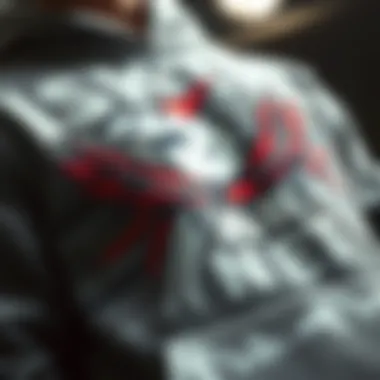
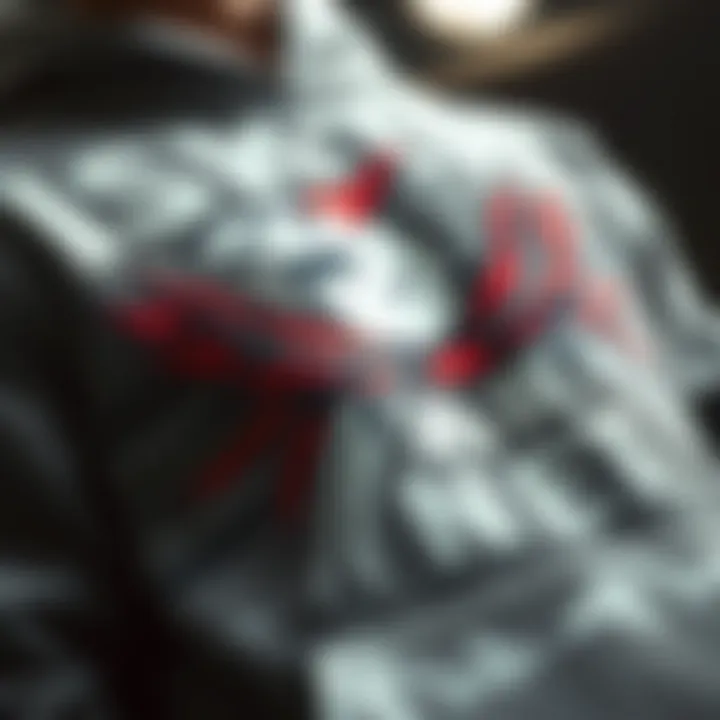
The graphic designs on skate apparel manifest as powerful vehicles of artistic expression. They often reflect the personal tastes of the wearer while resonating with broader cultural themes. Skateboarders have long used graphics to communicate their ideas, struggles, and beliefs. Statements or images related to social justice, environmental issues, or raw emotional experiences are common. For instance, an image of a broken skateboard might symbolize resilience in facing challenges on and off the board. Moreover, individual artists contribute to this vibrant interplay between art and identity—each graphic design is a reflection of stories behind the skater’s journey.
This artful storytelling enables skaters to carve out their unique space in the broader fabric of the community.
"Graphics are our voice, a way to connect with others in the skate world. When your hoodie has a design that speaks to someone else, it's like an unspoken bond."
By wearing specific graphics, skateboarders create solidarity within subgroups—members of a certain skate scene or followers of a particular artist often gather around shared aesthetics, deepening connections.
Branding Through Graphic Designs
When it comes to branding, graphic designs play a pivotal role. Brands like Supreme and Thrasher have become household names in skate culture, not just for their quality but for the statement their graphics make. Logos, illustrations, and typography used in these designs can evoke feelings of belonging or exclusivity. Skateboarding brands are not merely selling a product; they are marketing a lifestyle.
Consider how specific graphics become emblematic. An image from a well-known skate video or graphic designed by a street artist can elevate a basic hoodie into a sought-after item. Limited edition releases often create a buzz, drawing the attention of both collectors and casual fans alike.
For brands, it’s essential to strike the right balance between aesthetics and authenticity. Consumers, especially in the skate culture, can sniff out inauthenticity from miles away. The symbiosis between graphic design and branding contributes to a dynamic ecosystem that sustains the culture and keeps it vibrant.
Current Trends in Graphic Hoodies
As the world of skateboarding continues to evolve, so do the trends surrounding graphic hoodies and sweatshirts. These garments are not just about keeping warm; they encapsulate the spirit and vibe of the skate culture, reflecting the changing tastes and attitudes of skateboarders. Understanding current trends offers insights into how personal expression and communal identity play a crucial role within this subculture.
Popular Designs and Styles
Graphic hoodies today showcase a myriad of designs that reflect individual styles and movements within the skateboarding community. From classic logos to intricate artworks, these designs often tell a story or signify allegiance to certain brands or skateboard crews.
- Bold Typography: Many hoodies sport big, eye-catching texts, often with a rebellious touch. This type of typography not only enhances visibility but also serves as a statement piece, allowing wearers to express their beliefs.
- Artwork Collaboration: Many skateboard companies collaborate with graphic artists or tattooists to create unique designs that stand out in the crowded market. The fusion of illustration with fashion fosters a sense of art appreciation.
- Retro Aesthetics: There is a surge in nostalgia-driven designs that incorporate styles from the 90s and early 2000s. This trend often employs vibrant colors and geometric patterns, attracting both older skaters reliving their youth and younger ones seeking originality.
- Eco-Conscious Designs: Sustainability is becoming a buzzword in all fashion industries, including skate culture. Brands are starting to utilize organic materials and environmentally friendly inks, aligning with skateboarders' growing concern for the planet.
"Hoodies are like canvases, showcasing art, identity, and personal stories on the streets where we skate together."
Influence of Social Media on Trends
Social media undeniably plays a pivotal role in shaping the trends of graphic hoodies within skate culture. Platforms like Instagram and TikTok have turned into virtual galleries and marketplaces.
- Real-Time Sharing: Skateboarders can instantly showcase their outfits and styles to a global audience. This rapid sharing fosters a culture of inspiration, as new trends can spread like wildfire. As users see their favorite skaters rocking certain styles, they quickly adopt similar designs, keeping the trend cycle in constant motion.
- Influencer Collaborations: Popular skate influencers frequently collaborate with brands to create limited-edition hoodies, merging their personal brand with mainstream fashion. Their followers often rush to purchase these items, leading to increased visibility and sales for the collaborating brands.
- Street Style Documentation: Social media essentially archives the evolution of skate culture. Users can observe how graphic hoodies have transitioned in design, fitting styles, and material choices over the years. This accessibility to a shared history bolsters both unity and diversity in preferences among skaters.
In summary, being attuned to current trends in graphic hoodies and sweatshirts holds immense significance in understanding the evolving nature of the skateboarding culture. The artistic designs and the way social media fuels these trends reflects not only individual identities but also a continuously developing community ethos.
Material and Production Techniques
When it comes to graphic hoodies and sweatshirts in skate culture, the materials and production techniques play a pivotal role in shaping not just the garment’s aesthetic appeal, but also its functionality and longevity. Skateboarders, often engaged in rugged activities, require apparel that can withstand both the rigors of their sport and the environmental conditions they encounter. Thus, understanding the intricacies of fabric choices and printing methods becomes essential for both manufacturers and consumers.
Fabric Choices for Comfort and Durability
In the world of skate apparel, comfort and durability are the twin pillars on which the finest graphic hoodies stand. The choice of fabric can significantly influence wearability and life span. Common materials used in skate hoodies include cotton blends, polyester, and fleece.
- Cotton Blends: These garments offer warmth and breathability, making them perfect for skating on cooler days. Cotton tends to be soft against the skin, which adds to the comfort factor, especially for those extended skating sessions.
- Polyester: This synthetic material is often added for its quick-drying properties and resistance to shrinking and stretching. It can also lend a lightweight feel, which is crucial for active skaters who need freedom of movement.
- Fleece: For those chillier evenings, fleece-lined hoodies offer an extra layer of warmth without the bulk. This material provides insulation, crucial for skaters who often find themselves outdoors in various weather conditions.
A blend of these materials can balance comfort with durability, offering skaters the flexibility they crave while ensuring the apparel holds up under pressure. If a hoodie loses its shape after a few washes, it can be more than just a fashion faux pas; it could hinder performance. Hence, skate brands are increasingly opting for high-quality fabric blends that retain their original form.
"Choosing the right fabric is not just about feeling right; it’s about ensuring that your gear works with you, not against you."
Screen Printing vs. Direct-to-Garment Printing
When it comes to applying graphics, skate brands typically rely on two primary techniques: screen printing and direct-to-garment printing. Each has its own set of advantages and considerations, impacting both the final product's look and feel.
- Screen Printing: This traditional method involves pushing ink through a mesh screen onto the fabric. It produces vibrant colors and can create various textures. Screen printing is particularly suitable for designs with fewer colors; it allows for achieving that classic bold look often desired in skate graphics. However, changes or corrections in design can be costly and time-consuming due to the setup required for each color layer.
- Direct-to-Garment Printing (DTG): In contrast, DTG uses inkjet technology to print directly onto the fabric. This technique allows for intricate designs with a multitude of colors, making it ideal for those complex graphics that skate culture is known for. DTG printing does have its drawbacks, such as potentially fading more quickly than screen-printed designs, but it encourages creativity without the hefty setup costs of screen printing.
Both methods contribute distinct qualities to graphic hoodies, influencing how the designs feel against the skin and how they withstand the test of time during skateboarding activities. Ultimately, the choice between the two often comes down to the specific brand's aesthetics and values, reflecting a balance between art and functionality.
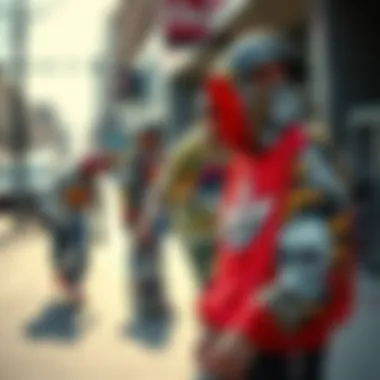
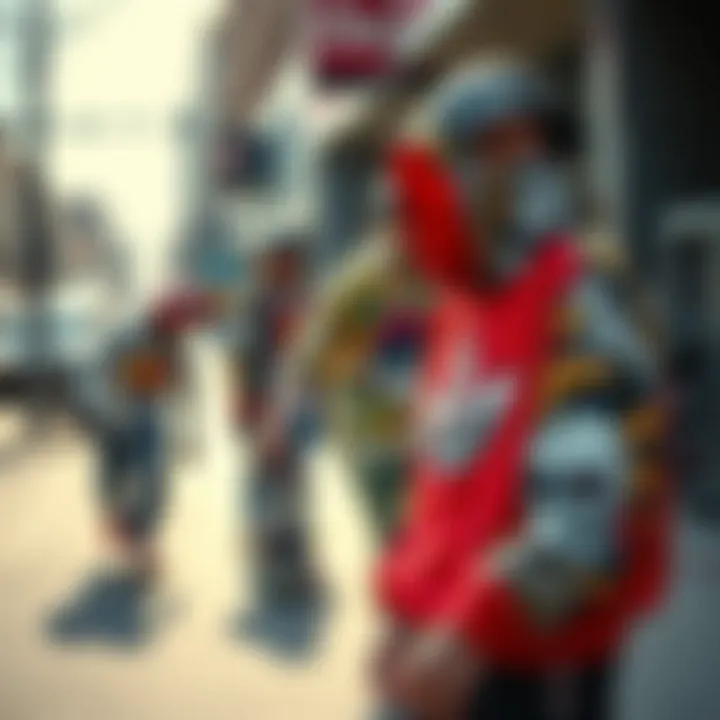
As the skate community continues to evolve, so does the approach in material and production techniques. Manufacturers must stay ahead of trends while accommodating performance needs, establishing a constant push toward innovation. In essence, these elements of production are crucial for the future of graphic hoodies within the skate culture.
Brand Spotlight: Major Players in Graphic Hoodies
When we talk about graphic hoodies in skate culture, we can’t overlook the influence of major brands that have shaped this aspect of style. These brands are not just selling clothing; they are crafting an identity and a narrative. They weave together art, lifestyle, and a sense of community, all while keeping the spirit of skateboarding alive. The garments they produce, particularly hoodies, have become an extension of the wearers, reflecting their attitudes, beliefs, and experiences.
Skateboard Brands with Iconic Designs
Several brands stand out in the crowded marketplace. Each one boasts unique designs that embody the culture and ethos of skateboarding. Brands like Supreme, Thrasher, and Santa Cruz have etched themselves into the fabric of skate culture with their iconic graphics. Their designs often depict bold, irreverent imagery that resonates with the rebellious spirit of skateboarders.
For instance, Thrasher, which began as a skateboard magazine, has become synonymous with the skateboarding community through its flame logo on hoodies that speaks volumes. It’s more than just a design; it connotes a lifestyle choice and a deep-rooted passion for the sport.
- Supreme capitalizes on exclusivity. Their limited-run hoodies often result in a frenzy among fans and resellers alike, showcasing how a brand can master demand and desirability simultaneously. Brands like these ensure that graphic hoodies are not just articles of clothing but emblems of culture and individuality.
- Santa Cruz, on the other hand, takes a different approach. Their designs often showcase vibrant colors and cartoons, capturing the fun side of skateboarding that appeals to a wide audience. These hoods allow skaters to express their playful side while maintaining that core skate culture vibe.
By examining these brands, we can see how graphic hoodies serve a dual purpose: they're functional pieces of clothing that protect skaters from the elements while also acting as visual statements. Hoodies carry messages that go beyond simple graphics; they represent collective experiences shared by skateboarders around the globe.
Collaborations and Limited Editions
Collaboration between brands is another exciting facet of this landscape. Often, skateboard brands will team up with notable artists or other companies to produce limited-edition graphic hoodies. These collaborations are highly sought after and often sell out in minutes, illustrating how desirability anchors itself in exclusivity.
A notable example is the collaboration between Adidas Skateboarding and various street artists. Each release often showcases a blend of classic skateboard aesthetics while marrying them with contemporary art, resulting in innovative designs. Similarly, Nike SB does not shy away from teaming up with renowned graphic designers, which results in hoodies that make a bold statement both on and off the board.
These limited edition releases create a sense of urgency among buyers, fueling a modern collector's culture that sees hoodie releases as an event rather than a mere purchase.
“Collaboration transcends mere branding; it forges connections between diverse cultures, illustrating the versatility of graphic hoodies.”
With each collaboration, brands showcase their adaptability and understanding of their consumers, a crucial element in today’s market. By infusing artistic ingenuity into functional apparel, they not only create demand but also foster a community that appreciates the blend of art and sport.
Ending
Ultimately, the major players in the world of graphic hoodies not only shape the aesthetic but also influence the cultural dialogue surrounding skateboarding. Their bold designs and partnerships make these garments much more than fashion; they reflect a lifestyle that is continually evolving. The dynamic relationship between these brands and the skateboarders who wear their apparel is a testament to the impact of graphic hoodies in skate culture.
The Cultural Impact of Graphic Apparel
The significance of graphic apparel, particularly in the realm of skate culture, extends far beyond just aesthetics. It embodies the spirit, values, and ethos of the community, making these garments vital tools for expression and identity. Graphic hoodies and sweatshirts don’t merely keep skaters warm in chilly weather; they tell a story, symbolize belonging, and act as canvases for personal and collective views.
In skateboarding, fashion is more than just fabric. The visual elements—ranging from logos and illustrations to vibrant splashes of color—mix and mingle to create a unique language. This visual identity links back to the roots of the sport, where personal styles were celebrated as an extension of the skateboarder’s persona. The cultural significance of these graphics becomes clear when you consider how they resonate with values such as freedom, rebellion, and creativity.
Identity Formation Among Skateboarders
The identity of skateboarders is often intertwined with the clothing they wear. Graphic hoodies serve as more than just attire; they act as statements of individuality. Each design reflects a part of the wearer’s personality, beliefs, or affiliations. For example, a skater wearing a Established 1996 hoodie not only showcases a brand but also aligns themselves with a history that many find to be cool and authentic.
As skaters cruise down the streets, their clothing becomes a badge of honor. These graphics reveal who they are and what community they relate to. More than just fashion, they are vehicles of self-identification.
Some skaters feel a strong connection to certain themes or iconography that resonates with their personal experiences or worldview. If a design incorporates a message about social justice, for instance, it signals solidarity with movements and aligns the wearer with a particular cause.
- Communal Identity: Wearing similar graphic designs can create a sense of belonging. Skaters recognize each other not only by skills on the board but also by the art on their sweatshirts.
- Cultural Narratives: Many graphics reflect broader social movements or cultural phenomena, serving as both commentary and celebration of where they stand in society.
Graphic Hoodies as Political Statements
In recent years, graphic hoodies have transformed into canvases for political expression. The blending of art and activism creates an intersection in which skaters can voice their opinions on crucial societal issues.
The use of graphic elements to convey political messages is a significant part of this trend. For instance, a hoodie adorned with messages about climate change or social inequality not only raises awareness but also invites conversations that extend beyond the skate park. A design featuring indigenous rights can foster dialogue about allyship and community relevance.
The impact of such apparel can be profound. It serves to inform those who might not be aware of pressing issues, thanks to bold visuals mixed in with skate fashion. Some notable points to consider include:
- Visibility of Causes: By donning statements on their clothing, skateboarders increase visibility for causes they deeply care about.
- Conversation Starters: Graphic hoodies become pieces that spark discussions among individuals. What starts as a hoodie can evolve into important dialogues regarding everything from governmental policies to social injustices.
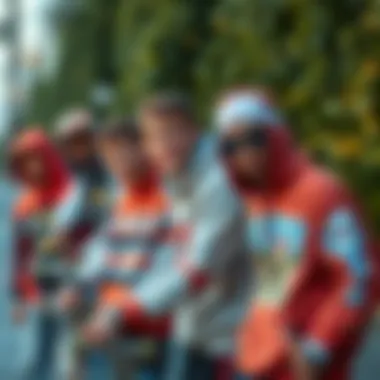
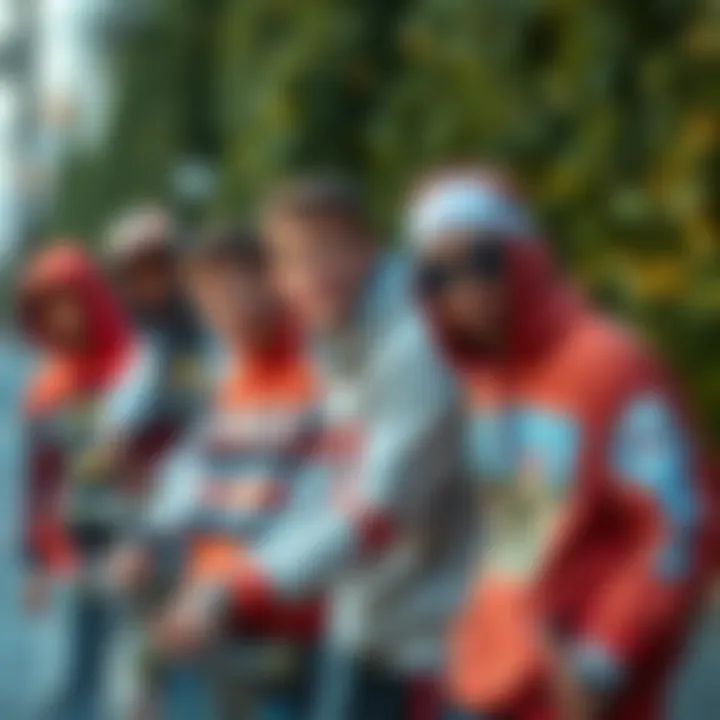
"Fashion is the armor to survive the reality of everyday life." – Bill Cunningham
The true essence of skate culture rests in its undying spirit. Graphic hoodies and sweatshirts serve as both tools of personal expression and political messages, highlighting the skateboarder's position within the larger social and cultural landscapes. As skate culture continues to evolve, so too will the graphics that embody its spirit, intertwining creativity with commentary on the world around.
Consumer Preferences: What Skaters Look For
When it comes to graphic hoodies and sweatshirts, skaters have a discerning eye. The choices they make reflect not just their personal style but also their connection to the skating culture at large. A hoodie is more than just a garment; it embodies comfort, a sense of belonging, and maybe even a bit of rebellion. Understanding what skaters prefer helps shed light on the intricate relationship between identity and apparel in the skate community.
Comfort vs. Aesthetic Appeal
Skaters often find themselves in a constant tug-of-war between comfort and aesthetic appeal. Comfort ranks high on their list because skateboarding is a physically demanding activity. A hoodie must enable freedom of movement while keeping the wearer warm during chilly rides. Many skaters gravitate towards oversized fits made from soft, breathable materials. These hoodies offer flexibility to perform tricks without feeling restricted.
On the other hand, aesthetic appeal cannot be overlooked. The graphics and designs serve as a visual language for the skater. A hoodie adorned with bold colors, unique artwork, or a vintage look can be a badge of honor within the community. "That hoodie caught my eye because it has an old-school graphic that takes me back," one skater might say. This duality – comfort and style – plays a crucial role in their purchasing decisions. When selecting a hoodie, skaters look for designs that resonate emotionally and socially, aligning with their identity and personal preferences.
Price Considerations in Purchases
Price is another pivotal element influencing skaters' choices in graphic apparel. Many skateboarding enthusiasts are younger individuals, often with limited budgets. Consequently, they seek a balance of quality and affordability. Skaters look for hoodies that offer durability without breaking the bank.
Importantly, brand loyalty can come into play here. Established brands like Thrasher or Supreme often carry a premium due to their reputation and the cultural capital they represent. However, some skaters prefer to support up-and-coming brands or local shops that might offer unique designs at a more accessible price point.
"It's not just about the cost, but the story behind the hoodie. I want something that feels authentic," a passionate skateboarder once noted.
Ultimately, skaters weigh these various factors against their budgets. They come to value not just the item they're purchasing, but what it signifies about their lifestyle and beliefs.
It's clear that consumer preferences within the realm of graphic hoodies and sweatshirts reveal deeper narratives about skaters themselves. Comfort and style, alongside financial considerations, intertwine to shape their apparel choices. By understanding these elements, brands can better tailor their products to meet the desires of this unique community.
Sustainability in Apparel Production
In the skateboarding culture, where self-expression and identity hold such high value, the recent shift toward sustainable practices in apparel production is proving significant. This growing focus on environmental responsibility resonates deeply with the community, as many skateboarders are eco-conscious and seek to align their fashion choices with their values. The impact of these practices spans far beyond mere aesthetics; it symbolizes a commitment to the planet and future generations.
Eco-Friendly Materials and Practices
Skateboarding apparel, especially graphic hoodies and sweatshirts, has traditionally involved materials that aren’t particularly kind to our environment. However, companies are increasingly adopting eco-friendly practices to combat this issue. One important step is using organic cotton, which uses much less water and avoids harmful pesticides compared to conventional cotton. This not only promotes soil health but also results in softer, more comfortable garments.
Moreover, fabrics made from recycled plastics are making an appearance. For instance, polyester derived from recycled bottles turns waste into wearable art, aligning perfectly with the ethos of recycling prevalent in the skate scene. This isn’t just a trend; it’s a remnant of the skateboarding community's rebellious spirit turning against wastefulness.
Beyond fabric, production processes are crucial as well. Ethical production practices that ensure fair wages and safe working conditions are becoming a priority. It’s about time businesses realize that a hoodie shouldn’t come at the cost of someone's dignity or our planet’s health.
The Movement Towards Sustainable Fashion
The drive for sustainable fashion is more than a fleeting trend in the skateboarding world; it’s a movement that reflects shifting values among consumers. Today’s skateboarders want their gear to reflect their commitment to sustainability. This shift is necessary and welcomed. By purchasing sustainable fashion, skaters are not just supporting brands; they are endorsing a lifestyle that prioritizes the environment.
This movement has taken root through social media. Brands that embrace sustainability often share their practices on platforms like Instagram and Facebook, showcasing their eco-friendly production methods and materials. This transparency builds trust and forms a strong bond with consumers who value authentic stories behind their garments.
"Sustainable fashion fosters the spirit of camaraderie; it’s about protecting the culture we love while being kind to our planet."
Some notable brands leading this charge include Patagonia, known for its commitment to the environment and social responsibility, and HUF, who has embraced recycled materials in their lines. Their efforts exemplify how blending skate culture with sustainability can create a stronger, impactful community.
The stakes keep getting higher as the climate crisis becomes harder to ignore. The responsibility lies on all of us, including skateboarders and brands, to push for a more sustainable future. As this movement gains momentum, it symbolizes not just a fashion choice but a declaration of values that resonate not only on grabs and ollies but also in our personal impact on the earth.
Finale: The Future of Graphic Hoodies in Skate Culture
As we wrap up our exploration of graphic hoodies and sweatshirts in the skate culture, it's clear that these garments are not just pieces of clothing; they are powerful conduits of identity, creativity, and community. The future of graphic hoodies within this realm appears promising, as skaters continue to push the boundaries of self-expression through art and fashion. Several key elements underscore the importance of this topic in contemporary discussions surrounding skate culture.
Evolving Trends
The landscape of graphic hoodies is continually evolving. Designs are now influenced by various cultural phenomena, including street art, urban environments, and the digital sphere. As skate culture adapts to the times, so do the graphics on these garments. Emerging artists often redefine aesthetics, bringing fresh, compelling visuals that serve to inspire new generations of skaters. We can expect that, as technology advances, the integration of interactive elements—like augmented reality—could make their way into graphic designs, enhancing the already vibrant storytelling aspect of these clothes.
The Push for Sustainability
Equally significant is the growing emphasis on sustainable practices. The skateboarding community is increasingly recognizing its collective responsibility to the environment. Brands that prioritize eco-friendly materials and production processes are likely to gain favor among consumers, who are becoming more mindful of the ecological impact of their purchases. This can lead to a shift in how graphic hoodies are produced, catering not just to style but also to environmental awareness.
"Sustainable fashion is not just a trend; it's a revolution in how we think about our impact on the planet."
Community Engagement
Graphic hoodies also play a crucial role in fostering community. They allow skaters to showcase their identity and affiliations, often serving as a badge of honor or a sign of loyalty to a particular brand or crew. Events such as skate competitions and art shows heavily feature these garments, strengthening relationships within the community and promoting a sense of belonging. As skate culture continues to grow globally, the designs might even reflect regional influences, further enriching the tapestry of styles and narratives.
Adapting to Digital Culture
Moreover, the digital realm cannot be overlooked. The influence of social media and online platforms for sharing art and skateboarding exploits means that trends can spread faster than ever. Designers have the opportunity to gauge reactions to their graphics almost instantaneously, allowing for a more responsive approach to trend evolution. This engagement can create a direct line between artists and consumers, satisfying desires for unique and personal expressions on fabric.
In summation, the future of graphic hoodies in skate culture is not just a matter of style but one of sustainability, community connection, and innovative expression. These elements combined will shape a vibrant and diverse future, continuously pushing the envelope and challenging norms. For skateboarders, brands, and enthusiasts alike, the journey is as exciting as the art on their backs offers unlimited potential for invention and cultural dialogue as they zip along their paths.







